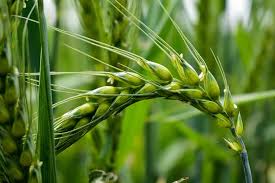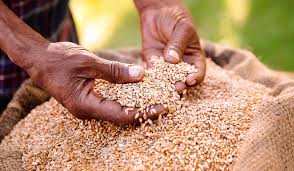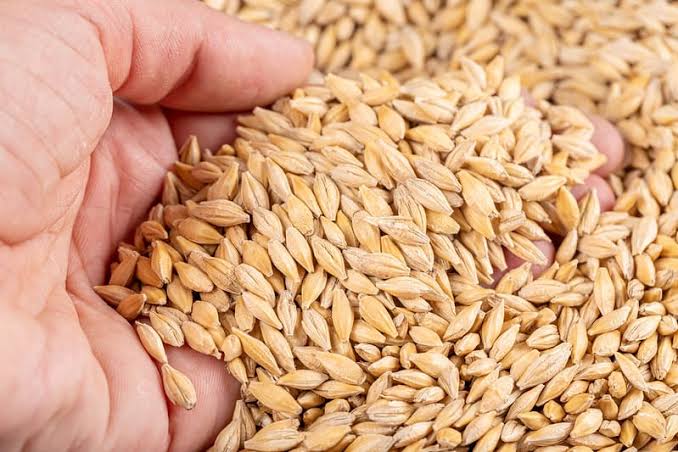Barley is a kind of grain. People have been growing and eating barley for a very long time. It’s a plant that grows in fields and has a lot of uses. Farmers plant barley seeds in the soil. These seeds then grow into tall plants with small golden grains on top. When the grains are ready, farmers harvest them. They can be used in many different ways.
One common use of barley is to make food. People grind the grains into flour, and with this flour, they can make bread, cakes, and other tasty treats. Barley is also used to make a special kind of food called barley soup. This soup is warm and comforting, especially on cold days.
Barley is not just for eating. It’s also important in making drinks. Some people use barley to brew beer. They soak the grains in water, let them ferment, and then, after a bit of time, they have beer. It’s a popular drink enjoyed by many people around the world.
But barley is not only good for food and drinks. It’s also good for the soil. Farmers plant barley as a cover crop to protect the soil from erosion. This helps keep the land healthy for other crops to grow.
In addition to being useful for people and the environment, barley is also food for animals. Farmers often give barley to their livestock, such as cows and chickens. It provides them with the nutrients they need to stay strong and healthy.
Barley is a versatile and important crop with a long history. From the fields to the kitchen, its golden grains bring nourishment and goodness to our tables. So, whether in a loaf of bread, a bowl of soup, or a refreshing glass of beer, barley plays a vital role in our lives, making it a grain worth celebrating.
Beyond its role in our daily meals, barley has even more to offer. One fascinating aspect of barley is its nutritional value. It contains essential nutrients like fiber, vitamins, and minerals that contribute to a balanced diet. The fiber in barley is particularly beneficial for digestion, helping to keep our stomachs happy and healthy.
Moreover, barley has a unique ability to adapt to different climates and soil conditions. This resilience makes it a reliable crop in various regions around the world. Farmers appreciate barley for its hardiness and versatility, as it can thrive in diverse environments, from cool mountainous areas to warmer plains.
In the agricultural cycle, barley plays a crucial role in crop rotation. Its cultivation helps break the cycle of pests and diseases, promoting a sustainable and environmentally friendly farming practice. This not only benefits the soil but also contributes to the overall health of agricultural ecosystems.
Barley has found its way into folklore and traditions too. In some cultures, it symbolizes prosperity and abundance. People use barley in rituals and celebrations, highlighting its cultural significance beyond its practical uses. Its golden fields waving in the breeze have inspired poets and artists, becoming a timeless representation of the beauty found in agriculture.
As we go into the world of barley, we discover its multifaceted nature, bridging the gap between sustenance, agriculture, and cultural heritage. From the simple joy of breaking bread to the intricate tapestry of agricultural sustainability, barley continues to weave its story through the fabric of human civilization.
Read Also: Preparation Method and Uses of Pig Meat
How to Grow and Care for Barley

Growing and caring for barley can be a rewarding experience. Here’s a simple guide to help you cultivate barley successfully:
1. Planting:
Choose the Right Location: Barley grows well in cool climates with well-drained soil. Select a location that receives plenty of sunlight.
Prepare the Soil: Barley prefers fertile soil. Before planting, work the soil to remove any weeds and ensure good aeration.
Sowing Barley Seeds: Plant barley seeds directly in the soil, about 1 to 1.5 inches deep. Space the seeds according to the recommended guidelines, usually a few inches apart.
2. Watering:
Keep the Soil Moist: Barley requires consistent moisture, especially during germination. Water the soil regularly to keep it consistently moist but not waterlogged.
Reduce Watering Before Harvest: As the barley matures, reduce watering to allow the grains to dry. This is crucial for a successful harvest.
3. Fertilizing:
Use Balanced Fertilizer: Apply a balanced fertilizer during the early stages of growth to provide essential nutrients.
Avoid Excessive Nitrogen: While nitrogen is beneficial, too much can lead to excessive foliage growth at the expense of grain development. Use nitrogen carefully.
4. Weeding:
Regular Weeding: Keep the barley field free from weeds, especially during the early stages when barley is establishing itself.
Mulching: Consider mulching around the plants to suppress weed growth and retain soil moisture.
5. Disease and Pest Control:
Monitor for Diseases: Keep an eye out for common barley diseases, such as powdery mildew or leaf rust. Apply appropriate fungicides if necessary.
Pest Management: Barley is generally resilient to pests, but occasional problems may arise. Use natural predators or organic pesticides to control pests.
6. Harvesting:
Timing is Key: Harvest barley when the grains are firm and the stalks have turned golden brown.
Cutting and Bundling: Use a scythe or sickle to cut the barley stalks just above the ground. Bundle them together and allow them to dry in the field.
7. Threshing and Storage:
Threshing: Separate the barley grains from the stalks by threshing – traditionally done by beating the bundles or using a machine.
Proper Storage: Store the harvested barley grains in a cool, dry place to prevent moisture and pest damage.
By following these basic steps, you can cultivate and care for barley successfully, whether you have a small garden or a larger agricultural plot. Remember to adapt these guidelines based on your specific climate and soil conditions.
Importance of Barley

The importance of barley extends across various aspects of human life and agriculture:
1. Food Security: Barley is a significant source of nutrition, providing essential nutrients such as fiber, vitamins, and minerals. Its cultivation contributes to food security by offering a versatile grain for various culinary purposes.
2. Agricultural Diversity: Barley’s adaptability to different climates and soil conditions enhances agricultural diversity. It serves as a rotational crop, breaking pest and disease cycles and promoting sustainable farming practices.
3. Economic Impact: Barley cultivation contributes to the economy through the production of grains used in the food and beverage industry. Barley-based products, such as bread, cereal, and beer, generate economic activity and employment opportunities.
4. Soil Health: Barley acts as a cover crop, protecting the soil from erosion and improving its structure. Its root system prevents nutrient leaching and enhances soil fertility, benefiting the overall health of agricultural lands.
5. Livestock Feed: Barley serves as an essential component of livestock feed, providing nutrients for animals like cows and chickens. This connection between barley and animal agriculture supports the production of meat and dairy products.
6. Cultural Significance: Barley holds cultural importance in various societies, symbolizing prosperity and abundance. It often features in traditions, rituals, and celebrations, connecting communities to their agricultural heritage.
7. Environmental Stewardship: Barley’s role as a cover crop contributes to environmental stewardship by reducing the need for synthetic fertilizers and promoting sustainable farming methods. Its cultivation supports biodiversity and ecosystem health.
8. Culinary Enjoyment: Barley adds diversity to the human diet, offering a range of culinary delights such as barley soup, bread, and beverages like beer. Its versatility in the kitchen enhances the overall enjoyment of meals.
In addition, the importance of barley encompasses not only its role in providing sustenance but also its impact on agriculture, economy, culture, and environmental sustainability. As a resilient and adaptable crop, barley continues to play a vital role in shaping diverse aspects of human life and the natural world.
Read Also: Inbreeding, Importance and It’s Effect in Pig Farming
Uses of Barley

Barley finds versatile uses across various domains, making it a valuable crop with a wide range of applications:
1. Culinary Uses:
Bread and Baked Goods: Barley flour is used in baking, contributing to the creation of bread, cakes, and other baked goods.
Barley Soup: Barley is a key ingredient in hearty and nutritious soups, adding texture and flavor.
Breakfast Cereals: Barley flakes or grits are often included in breakfast cereals for a wholesome start to the day.
2. Beverages:
Beer Production: Barley is a primary ingredient in beer brewing. Malted barley undergoes fermentation, resulting in the production of beer.
3. Animal Feed:
Livestock Feed: Barley serves as a nutritious component of animal feed, supporting the health and development of livestock such as cows and chickens.
4. Cover Crop:
Soil Erosion Prevention: Barley is used as a cover crop to protect soil from erosion, particularly during periods when fields might otherwise be bare.
5. Agriculture and Crop Rotation:
Crop Rotation: Barley is employed in crop rotation strategies to break cycles of pests and diseases, promoting healthier soil for subsequent crops.
6. Health and Nutrition:
Dietary Fiber: Barley is a good source of dietary fiber, which aids in digestion and promotes overall digestive health.
Nutrient Content: Barley contains essential nutrients such as vitamins, minerals, and antioxidants, contributing to a balanced diet.
7. Industrial Uses:
Malting Industry: Barley is a key grain used in the malting process, providing malt for various industrial applications, including the production of malted beverages.
8. Landscaping:
Ornamental Landscaping: Barley fields can be cultivated for ornamental purposes, contributing to the aesthetic appeal of landscapes.
9. Traditional and Cultural Uses:
Symbolism: Barley holds cultural significance in various traditions, symbolizing prosperity, fertility, and abundance.
10. Environmental Benefits:
Cover Cropping: Barley’s use as a cover crop contributes to soil health, erosion control, and sustainable agricultural practices.
The diverse uses of barley highlight its adaptability and importance in both traditional and modern contexts, from the kitchen to the farm and beyond.
Read Also: Cost of Starting a Waste Management Business
